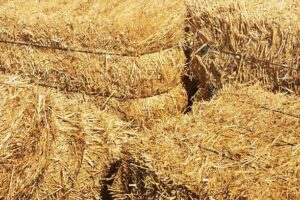Twine that’s left loose in fields and stalls can lead to serious injury or even death. Prevention is a small investment compared to the cost of vet calls, medical care or machinery repairs.
From sisal to polypropylene, there are a number of options for binding forage bales. Learn more about these baling twine online options and the tensile strength and knot strength that you need to know when selecting your twine.
Natural Fiber
 This natural fibre baler twine for hay baling is a rugged, tightly woven twine spun from select-grade Brazilian agave sisalana. It works flawlessly in square baler machinery and is treated to guard against rot, mildew and rodents. With a 130 lb test, this twine is strong enough to handle rough balers and heavy bales, yet it cuts easily, making the job quicker and easier. It’s also biodegradable, so you won’t have old twine left to clog your machines over the years.
This natural fibre baler twine for hay baling is a rugged, tightly woven twine spun from select-grade Brazilian agave sisalana. It works flawlessly in square baler machinery and is treated to guard against rot, mildew and rodents. With a 130 lb test, this twine is strong enough to handle rough balers and heavy bales, yet it cuts easily, making the job quicker and easier. It’s also biodegradable, so you won’t have old twine left to clog your machines over the years.
Two rolls of 9000 ft each. Made for use in the Paddock Mini Baler, but can be used on a wide range of hay-baling machinery. This sisal twine is knotless, so it makes tying and packing quick and easy. It’s also treated to resist rot, mildew and rodents, so you can be sure it won’t harm your crops or the environment.
Featuring advanced ultra-grip technology, this high-visibility bailer twine is designed to grip tightly in the worst weather conditions. It’s woven with a unique blend of tough polypropylene and soft agave sisalana fibres to provide the durability you need for trouble-free baling. This bailer twine is rated for up to 100 round bales with the Paddock Mini Baler and up to 150 round bales with other machines. It has a high tensile strength and is woven with UV inhibitors to protect against light degradation.
Polypropylene
Unlike sisal twine, which is made from individual strands of natural material twisted together, polypropylene baling twine online has a more solid, plastic polymer base. It makes it much stronger and able to handle far higher weights than the natural sisal variety, making it ideal for hay baling.
It also doesn’t degrade like natural sisal twine and won’t break down if washed, which means it can continue to hold tightly even in harsh conditions. It makes it a great choice for use on a wide range of different crops, hay bale sizes and shapes.
As well as a large range of different twine types, phs Wastekit also supplies a wide range of baler accessories, including a selection of different bale wraps and nets. We also sell a range of twine hooks, twine forks, bale ties and baler trolleys.
It’s important to remember that despite being very durable if used incorrectly or over time, plastic baling twine can be a hazard. When loading twine into a baler machine, it’s best to follow the instructions provided by the manufacturer. It will ensure you get the most out of your state-of-the-art machinery and avoid any unforeseen problems.
Insect Resistant
If you’re a farmer or rancher who makes your living off the land, you know the importance of choosing the right twine for hay baling. It’s crucial to make sure the twine you use is made from high-quality materials and can withstand the heavy weight of your bales. You can choose from natural fibre sisal or polypropylene twine in a variety of colours and strengths. Some twines also resist mildew and rot to help keep your bales protected for the long haul.
When choosing a twine, it’s important to consider knot strength and tensile strength. The knot strength of twine refers to the number of twists it can hold before breaking, while tensile strength is how much force a single length of twine can support before it breaks. Most manufacturers will list both numbers on their packaging to give you a better idea of the twine’s strength and durability.
It’s also important to clean up your baling twine online after each use to prevent it from becoming a danger to wildlife. If you leave old twine in a field or pasture, it can be picked up by Osprey and used in their nests, which can have disastrous consequences for the birds. Osprey that become tangled in twine can lose their wing or legs, and they can’t fly to hunt for food. Cleaning up your twine can prevent these problems by making it less attractive to Osprey and other animals that might try to use it as nesting material.